Enterprise SaaS companies usually start by implementing their own solution. Sometimes they charge explicitly and other times it is simply treated as a cost of doing business. As its business grows, it inevitably confronts the question of how to scale such services. Unless implementation is simple, it cannot be indefinitely treated as a cost of doing business. The services either need to priced or partners need to be found to provide them.
There are a series of considerations that affect the best decision for your business. An obvious one is control of customer success. There is little doubt that handling the implementations directly allows more influence over the ultimate outcome of the customer’s use of your solution.
On the other hand, a partner network that can handle the implementations offers some countervailing advantages. The partner network can positively influence sales since partners will have a vested interest in keeping their practices busy and growing. Additionally, if the business experiences rapid growth, a vibrant partner network is more capable of scaling implementation capability quickly to keep pace.
There are also financial considerations. On the positive side for doing it yourself, a well-run Services business generates nice profits, as well as steady and predictable cash flow. However, the Services revenue will be valued at a much lower revenue multiple than subscription revenue. Of course, in the really long run, companies are valued on profit growth and, if it is best for the business to handle its own implementation services, the key is to focus on delivering those profitably while driving customer success.
Another consideration entered my thinking when deciding how to handle this at Demandware (we mostly outsourced implementation services). Our company was ultimately going to be valued based upon our technology solution and I wanted us to be 100% focused on ensuring that solution delivered very high value to our customers. A large and active Services operation can mask problems and that was a risk which we did not want to run.
Understanding the advantages and disadvantages of the two different approaches is useful, but the history of successful SaaS companies demonstrates that the answer can be different for different companies. Salesforce, for example, has over 90% of its revenue coming from subscriptions whereas NetSuite had less than 80% and did many of its own implementations. And Veeva proudly claims to have a professional services relationship with every customer.
There are some key aspects of your business that determine the best course. These include the following:
- Has customer success been sufficiently demonstrated? When there are still few (or no) examples of customer success with your solution, it is much more important to control the implementation. This is necessary both so you can completely understand the required ingredients for success and so that you can adapt the technology to have those features it requires to support that success.
- Will the implementations be large enough and frequent enough to attract an ecosystem of partners? Implementation partners need to grow revenue and, if there will not be enough demand around your solution, they will either not engage or will layer on so many additional services that the cost of your solution will become prohibitive.
- How important is it to be ready for a rapid expansion of implementation services capability? Having the requirement for such an expansion and not being able to provide it would limit the company’s growth. If this is required, having partners with strong services capabilities could offer an excellent solution. Alternatively, if you are doing the services, it places a premium on adding a very experienced Services executive to lead the effort so the executive can leverage previous experience to rapidly grow such an organization.
- How difficult is it to enhance the software to enable third parties to work effectively on implementations and will such enhancements successfully compete for prioritization with other product roadmap needs? There are requirements for a different API structure, more API’s, more documentation, and a different support structure to enable third parties to be effective.
If the decision to outsource implementation services has been made, how do you go about it? First, recognize that to do it right while maintaining high levels of customer success will take time. A high priority is finding a leader of your Services organization who has experience leading a Services organization inside a rapidly growing SaaS/software company. It is vital that you have a lot of trust in this individual. Otherwise, you run the same risk as doing the services yourself – i.e. having the services be a major distraction from the company’s attention to its technology.
The software changes that are required for third party implementations should be complete and proven by having your own implementation use them successfully (at arms-length from your R&D organization). Then you can begin the process of training, certifying, and monitoring partners. This is best done by the services organization itself, often by first using partner personnel as subcontractors on projects you lead. Next the partner can lead a project using some of your team as subcontractors. Ultimately the partner can run projects totally independently. It is important to maintain a monitoring capability both for the partner organization as a whole (ensuring a high proportion of their projects go well) and for individual projects. You want to ensure that projects are implemented in such a way that the customer is set up for long term success.
An often overlooked ingredient for success is the preparation of your sales force. The path to least resistance for a sales rep can be to use the internal services team. The sales team needs to be equipped to talk about the advantages of partner led implementations. It may be worthwhile to provide incentives for the early usages of partners and then to publicize those success stories, particularly ones where the partner has been influential in the sale.
In the long run, it is important to keep a core services capability yourself. They would handle implementations that were highly risky or unique (new use case for your solution, new vertical, significantly different scale of customer) or where the customer absolutely demanded that you do it. They would thus maintain deep knowledge of the implementation process which would help them be effective and knowledgeable monitors of partner implementations as well as lending them credibility in presales situations.



